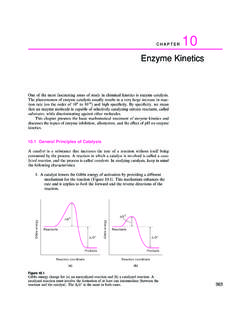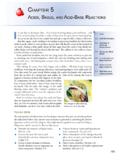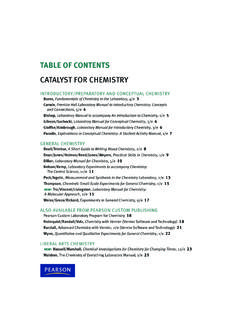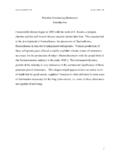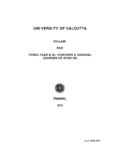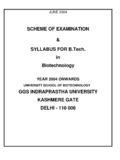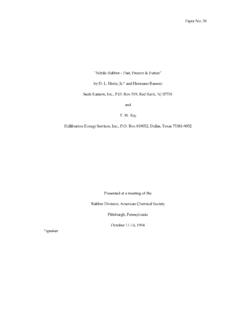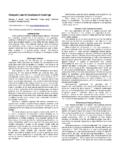Transcription of ModernPhysicalOrganicChemistry - University …
1 modern physical organic , ,CaliforniaUniversity Science Manager:ChristineTaylorManuscript Editor:JohnMurdzekDesign:RobertIshiIllus trator:LineworksCompositor:Wilsted&Taylo rPublishingServicesPrinter & Binder:EdwardsBrothers, book is printed on acid-free 2005 by University Science BooksReproduction or translation of any part of this work beyond that permitted bySection 107 or 108 of the 1976 United States Copyright Act without the permissionof the copyright owner is unlawful. Requests for permission or further informationshould be addressed to the Permissions Department, University Science of Congress Cataloging-in-Publication DataAnsyln, Eric V., 1960 modern physical organic chemistry / Eric V. Anslyn, Dennis A. bibliographical references and 1 891389 31 9 (alk. paper)1. chemistry , physical organic . I. Dougherty, Dennis A., 1952 II. 2004547 .13 dc222004049617 Printed in the United States of America090807060510987654321vAbbreviated ContentspartI: Molecular Structure and Thermodynamicschapter1.
2 Introduction to Structure and Models of Bonding 32. Strain and Stability 653. Solutions and Non-Covalent Binding Forces 1454. Molecular Recognition and Supramolecular chemistry 2075. Acid Base chemistry 2596. Stereochemistry 297partII: Reactivity, Kinetics, and Mechanismschapter7. Energy Surfaces and Kinetic Analyses 3558. Experiments Related to Thermodynamics and Kinetics 4219. Catalysis 48910. organic Reaction Mechanisms, Part 1:Reactions Involving Additions and/or Eliminations Reaction Mechanisms, Part 2:Substitutions at Aliphatic Centers and ThermalIsomerizations/Rearrangements 62712. Organotransition Metal Reaction Mechanisms and Catalysis 705 Intent and Purpose 70513. organic Polymer and Materials chemistry 753partIII: Electronic Structure: Theory and Applicationschapter14. Advanced Concepts in Electronic Structure Theory 80715. Thermal Pericyclic Reactions 87716. Photochemistry17. Electronic organic Materials 1001appendix1. Conversion Factors and Other Useful Data 00002.
3 Electrostatic Potential Surfaces for Representative organic Molecules 00003. Group Orbitals of Common Functional Groups:Representative Examples Using Simple Molecules 00004. The organic Structures of Biology 00005. Pushing Electrons 00006. Reaction Mechanism Nomenclature 0000viiContentsList of Highlights00 Preface00 Acknowledgments00 ANote to the Instructor00PA R TIMOLECULAR STRUCTURE ANDTHERMODYNAMICSCHAPTER1: Introduction to Structure andModels of Bonding 3 Intent and Purpose A Review of Basic Bonding Quantum Numbers and Atomic Orbitals Electron Configurations and Electronic Diagrams Lewis Structures Formal Charge Hybridization A Hybrid Valence Bond/Molecular OrbitalModel of Bonding 10 Creating Polar Covalent Bonding 12 Electronegativity12 Electrostatic Potential Surfaces14 Inductive Effects15 Group ElectronegativitiesHybridization Bond Dipoles, Molecular Dipoles,and Quadrupoles 17 Bond Dipoles17 Molecular Dipole Moments18 Molecular Quadrupole Resonance Bond Lengths Polarizability Summary of Concepts Used for the SimplestModel of Bonding in organic Structures A More modern Theory of organic Molecular Orbital Theory A Method forQMOT Methyl in Detail 29 Planar Methyl29 The Walsh Diagram.
4 Pyramidal Methyl31 Group Orbitals for Pyramidal Methyl32 Putting the Electrons In The The CH2 Group in Detail 33 The Walsh Diagram and Group Orbitals33 Putting the Electrons In The Orbital Mixing Building Larger Using Group Orbitals to Make Ethane Using Group Orbitals to Make Ethylene The Effects of Heteroatoms Formaldehyde Making More Complex Alkanes Three More Examples of Building LargerMolecules from Group Orbitals 43 Propene43 Methyl Group Orbitals of Representative Systems:Benzene, Benzyl, and Allyl Understanding Common FunctionalGroups as Perturbations of Allyl The Three Center Two Electron Bond Summary of the Concepts Involved inOur Second Model of Bonding Bonding and Structures of Reactive Carbocations 52 Carbenium Ions53 Interplay with Carbonium Ions54 Carbonium Carbanions Radicals Carbenes A Very Quick Look at Organometallicand Inorganic Bonding59 Summary and Outlook61 EXERCISES62 FURTHER READING64 CHAPTER2: Strain and Stability65 Intent and Thermochemistry of Stable The Concepts of Internal Strainand Relative Stability Types of Energy 68 Gibbs Free Bond Dissociation Energies 70 Using BDEs to Predict Exothermicityand An Introduction to Potential Functionsand Surfaces Bond Stretches 73 Infrared Heats of Formation and Combustion The Group Increment Method Strain Energy Thermochemistry of Reactive Stability vs.
5 Persistence Radicals 83 BDEsasaMeasure of Stability83 Radical Persistence84 Group Increments for Carbocations 87 Hydride Ion Affinities as a Measure of Stability87 Lifetimes of Carbanions Summary Relationships Between Structure and Energetics Basic Conformational Acyclic Systems Torsional Potential Surfaces 92 Ethane92 Butane The Gauche Interaction95 Barrier Height97 Barrier Foldedness97 Tetraalkylethanes98 The g+g Pentane Interaction99 Allylic (A1,3) Basic Cyclic Systems 100 Cyclopropane100 Cyclobutane100 Cyclopentane101 Cyclohexane102 Larger Rings Transannular Effects107 Group Increment Corrections for Ring Systems109 Ring Torsional Modes109 Bicyclic Ring Systems110 Cycloalkenes and Bredt s Rule110 Summary of Conformational Analysis andIts Connection to Electronic Interactions Involving Systems 112 Substitution on Alkenes112 Conformations of Substituted Alkenes113 Conjugation115 Aromaticity116 Antiaromaticity, An Unusual Destabilizing Effect117 NMRC hemical Shifts118 Polycyclic Aromatic Hydrocarbons119 Large Effects of Multiple Heteroatoms 120 Bond Length Effects120 Orbital Highly-Strained Long Bonds and Large Angles Small Rings Very Large Rotation Barriers Molecular The Molecular Mechanics Model 129 Bond Stretching129 Angle Bending130 Torsion130 Nonbonded Interactions130 Cross Terms131 Electrostatic Interactions131 Hydrogen Bonding131 The Parameterization132 Heat of Formation and Strain General Comments on the MolecularMechanics Method Molecular Mechanics on Biomolecules andUnnatural Polymers Modeling Molecular Mechanics Studies of Reactions 136 Summary and Outlook137 EXERCISES138 FURTHER READING143 CHAPTER3.
6 Solutions and Non-CovalentBinding Forces145 Intent and Solvent and Solution Nature Abhors a Vacuum Solvent Scales 146 Dielectric Constant147 Other Solvent Scales148 Heat of Vaporization150 Surface Tension and Solubility 153 General Overview153 Shape154 Using the Like-Dissolves-Like Solute Mobility 155 Diffusion155 Fick s Law of Diffusion156 Correlation The Thermodynamics of Solutions 160 Chemical Potential158 The Thermodynamics of Reactions160 Calculating H and S Binding Ion Pairing Interactions 163 Salt Electrostatic Interactions Involving Dipoles 165 Ion Dipole Interactions165 ASimple Model of Ionic Solvation The Born Equation166 Dipole Dipole Hydrogen Bonding 168 Geometries169 Strengths of Normal Hydrogen Bonds171i. Solvation Effects171ii. Electronegativity Effects172iii. Resonance Assisted Hydrogen Bonds173iv. Polarization Enhanced Hydrogen Interactions in HydrogenBonding Systems175ixCONTENTSvi. Cooperativity in Hydrogen Bonds175 Vibrational Properties of Hydrogen Bonds176 Short Strong Hydrogen Effects 180 Cation pInteractions181 Polar pInteractions183 Aromatic Aromatic Interactions (pStacking)184 The Arene Perfluoroarene Interaction184pDonor Acceptor Induced-Dipole Interactions 186 Ion Induced-Dipole Interactions187 Dipole Induced-Dipole Interactions187 Induced-Dipole Induced-Dipole Interactions188 Summarizing Monopole, Dipole, andInduced-Dipole Binding The Hydrophobic Effect 189 Aggregation of Organics189 The Origin of the Hydrophobic Computational Modeling of Continuum Solvation Models Explicit Solvation Models Monte Carlo (MC) Methods Molecular Dynamics (MD) Statistical Perturbation Theory/Free Energy Perturbation 200 Summary and Outlook201 EXERCISES202 FURTHER READING204 CHAPTER4.
7 Molecular Recognition andSupramolecular Chemistry207 Intent and Thermodynamic Analyses of General Thermodynamics of Binding 208 The Relevance of the Standard State210 The Influence of a Change in Heat Capacity212 Cooperativity213 Enthalpy Entropy The Binding Isotherm Experimental Methods 219UV/Vis or Fluorescence Methods220 NMRM ethods220 Isothermal Molecular Complementarity and Preorganization 224 Crowns, Cryptands, and Spherands MolecularRecognition with a Large Ion Dipole Component224 Tweezers and Molecular Recognition with a LargeIon Pairing Component Molecular Recognition with a Large HydrogenBonding Component 230 Representative Structures230 Molecular Recognition via HydrogenBonding in Molecular Recognition with a LargeHydrophobic Component 234 Cyclodextrins234 Cyclophanes234 ASummary of the Hydrophobic Componentof Molecular Recognition in Molecular Recognition with a Large Component 239 Cation pInteractions239 Polar pand Related Summary Supramolecular Supramolecular Assembly of ComplexArchitectures 244 Self-Assembly via Coordination Compounds244 Self-Assembly via Hydrogen Novel Supramolecular Architectures Catenanes,Rotaxanes, and Knots Container Compounds Molecules withinMolecules 249 Summary and Outlook252 EXERCISES253 FURTHER READING256 CHAPTER5.
8 Acid Base Chemistry259 Intent and Br nsted Acid Base Aqueous pH The Leveling Effect Activity vs. Concentration Acidity Functions: Acidity Scales for HighlyConcentrated Acidic Solutions Super Acids Nonaqueous pKaShifts at Enzyme Active Sites Solution Phase vs. Gas Phase Predicting Acid Strength in Methods Used to Measure Weak Acid Strength Two Guiding Principles for PredictingRelative Acidities Electronegativity and Induction Resonance Bond Strengths Electrostatic Effects Hybridization Aromaticity Solvation Cationic organic Structures Acids and Bases of Biological Lewis Acids/Bases and The Concept of Hard and Soft Acids and Bases, GeneralLessons for Lewis Acid Base Interactions, and RelativeNucleophilicity and Electrophilicity 289 Summary and Outlook292 EXERCISES292 FURTHER READING294 CHAPTER6: Stereochemistry297 Intent and Stereogenicity and Basic Concepts and Terminology 298 Classic Terminology299 More modern Stereochemical Descriptors 303R,S System304E,Z System304dandl304 Erythro and Threo305 Helical Descriptors M and P305 Ent and Epi306 Using Descriptors to Compare Distinguishing Enantiomers 306 Optical Activity and Chirality309 Why is Plane Polarized Light Rotatedby a Chiral Medium?
9 309 Circular Dichroism310X-Ray Symmetry and Basic Symmetry Operations Chirality and Symmetry Symmetry Arguments Focusing on Carbon Topicity Homotopic, Enantiotopic, and Diastereotopic Topicity Descriptors Pro-R/Pro- Chirotopicity Reaction Stereochemistry: Stereoselectivityand Simple Guidelines for Reaction Stereochemistry Stereospecific and Stereoselective Reactions Symmetry and Time Topological and Supramolecular Loops and Knots Topological Chirality Nonplanar Graphs Achievements in Topological and SupramolecularStereochemistry Stereochemical Issues in Polymer Stereochemical Issues in Chemical The Linkages of Proteins, Nucleic Acids,and Polysaccharides 333 Proteins333 Nucleic Helicity 336 Synthetic Helical The Origin of Chirality in Nature Stereochemical Terminology340 Summary and Outlook340 EXERCISES344 FURTHER READING350PA R TIIR eactivity, Kinetics, and MechanismsCHAPTER7: Energy Surfaces andKinetic Analyses355 Intent and Energy Surfaces and Related Energy Surfaces Reaction Coordinate Diagrams What is the Nature of the ActivatedComplex/Transition State?
10 Rates and Rate Constants Reaction Order and Rate Laws Transition State Theory (TST) and Related Topics The Mathematics of Transition State Theory Relationship to the Arrhenius Rate Law Boltzmann Distributions and TemperatureDependence Revisiting What is the Nature of the ActivatedComplex? and Why Does TST Work? Experimental Determinations of Activation Parametersand Arrhenius Parameters Examples of Activation Parameters andTheir Interpretations Is TST Completely Correct? The Dynamic Behaviorof organic Reactive Intermediates Postulates and Principles Relatedto Kinetic The Hammond Postulate The Reactivity vs. Selectivity Principle The Curtin Hammett Principle Microscopic Reversibility Kinetic vs. Thermodynamic Control Kinetic How Kinetics Experiments are Performed Kinetic Analyses for Simple Mechanisms 384 First Order Kinetics385 Second Order Kinetics386 Pseudo-First Order Kinetics387 Equilibrium Kinetics388 Initial-Rate Kinetics389 Tabulating a Series of Common Kinetic Complex Reactions Deciphering Steady State Kinetics Using the SSA to Predict Changesin Kinetic Order Saturation Kinetics Prior Rapid Equilibria Methods for Following Reactions with Half-Lives Greaterthan a Few Seconds Fast Kinetics Techniques 398 Flow Techniques399 Flash Photolysis399 Pulse Relaxation Methods Summary of Kinetic Analyses Calculating Rate Marcus Theory Marcus Theory Applied to Electron Transfer Considering Multiple Reaction Variation in Transition State Structures AcrossaSeries of Related Reactions An ExampleUsing Substitution Reactions More O Ferrall Jencks Plots Changes in Vibrational State Along the ReactionCoordinate Relating
